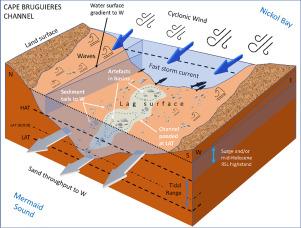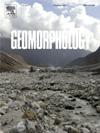将地质考古学原理应用于海洋考古:对澳大利亚西北部穆鲁朱加(丹皮尔群岛)"第一海洋 "和 "原地 "碎石散落的新评价
IF 3.1
2区 地球科学
Q2 GEOGRAPHY, PHYSICAL
引用次数: 0
摘要
澳大利亚内陆架上没有或很少有已知的水下文化遗产(UCH)遗址,这与世界其他地方发现的数以千计的遗址形成了鲜明对比。一系列论文声称,澳大利亚西北部穆鲁朱加(丹皮尔群岛)浅水区发现了首个原地(即原生环境)水下文化遗产遗址,每篇论文都认为这些石器散落点至少有 7000 年的历史,现在由于冰川期后海平面上升而被淹没。随后的论文提供了新的数据,并重复了这些说法。我们提出了新的水动力模型以及海岸侵蚀和水深测量数据,并重新评估了每个遗址的沉积环境和考古遗址形成史。所有出土文物的年代都不清楚,许多或所有出土文物都可能经过了再加工,包括飞沫通道的潮下带出土文物。如果处理得当,这些次生遗址可以帮助我们了解遗址的形成过程,并为水下考古学做出比寻找最早或最古老遗址更有力的贡献。本文章由计算机程序翻译,如有差异,请以英文原文为准。

Applying geoarchaeological principles to marine archaeology: A new reappraisal of the “first marine” and “in-situ” lithic scatters, Murujuga (Dampier Archipelago), NW Australia
The absence or paucity of known underwater cultural heritage (UCH) sites on the Australian inner shelf stands in stark contrast to the thousands of sites revealed elsewhere in the world. A series of papers have asserted the first in situ (i.e., primary context) UCH sites in the shallow waters of Murujuga (Dampier Archipelago), NW Australia, each arguing the stone artefact scatters are at least 7000 years old and are now submerged because of Post-Glacial sea-level rise. Subsequent papers presented new data and repeated these claims. We present new hydrodynamic modelling and data on coastal erosion and bathymetry, and re-assess each sites' sedimentary setting and archaeological site-formation history.
The arguments for these sites being of primary context and reflecting Early Holocene land surfaces are unfounded, and at best untested. All artefacts are of unknown age, and many or all are likely to have been reworked, including the subtidal artefacts in Flying Foam Passage. Such sites of secondary context, if treated appropriately, can inform our understanding of site-formation processes, and may support more powerful contributions to submerged archaeology than attempts to seek the first or the oldest.
求助全文
通过发布文献求助,成功后即可免费获取论文全文。
去求助
来源期刊

Geomorphology
地学-地球科学综合
CiteScore
8.00
自引率
10.30%
发文量
309
审稿时长
3.4 months
期刊介绍:
Our journal''s scope includes geomorphic themes of: tectonics and regional structure; glacial processes and landforms; fluvial sequences, Quaternary environmental change and dating; fluvial processes and landforms; mass movement, slopes and periglacial processes; hillslopes and soil erosion; weathering, karst and soils; aeolian processes and landforms, coastal dunes and arid environments; coastal and marine processes, estuaries and lakes; modelling, theoretical and quantitative geomorphology; DEM, GIS and remote sensing methods and applications; hazards, applied and planetary geomorphology; and volcanics.
 求助内容:
求助内容: 应助结果提醒方式:
应助结果提醒方式:


